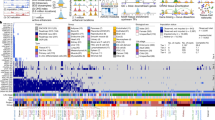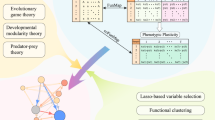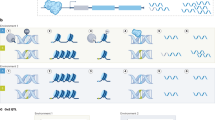Abstract
Analysis of epistasis, or gene–gene interactions, is of particular importance for revealing the molecular mechanisms of complex human diseases. Multiple genes, each of which has a moderate effect, might interact and produce a complex phenotypic trait. In this paper, we present a novel method of epistasis analysis, utilizing multiple phase-resolved haplotypes residing in different genomic regions. Prediction models can then be derived from the epistasis to indicate the susceptibility of a person to a dichrotomous phenotypic trait. The simulation results showed that the prediction accuracy of this method is dependent on the penetrance rate of the underlying model. The computation cost, on the other hand, is dependent on the number of genomic regions involved for the complex phenotypic trait.
Similar content being viewed by others
Log in or create a free account to read this content
Gain free access to this article, as well as selected content from this journal and more on nature.com
or
References
Bell JT, Wallace C, Dobson R, Wiltshire S, Mein C, Pembroke J, Brown M, Clayton D, Samani N, Dominiczak A et al (2006) Two-dimensional genome-scan identifies novel epistatic loci for essential hypertension. Hum Mol Genet 15:1365–1374
Carlborg O, Haley CS (2004) Epistasis: too often neglected in complex trait studies. Nature 5:618–625
Carlson CS, Eberle MA, Rieder MJ, Yi Q, Kruglyak L (2004) Selecting a maximally informative set of single-nucleotide polymorphisms for association analyses using linkage disequilibrium. Am J Hum Genet 74:106–120
Epstein MP, Satten GA (2003) Inference of haplotype effects in case-control studies using unphased genotype data. Am J Hum Genet 73:1316–1329
Evans DM, Cardon LR, Morris AP (2004) Genotype prediction using a dense map of SNPs. Genet Epidemiol 27:375–384
Fallin D, cohen A, Essioux L, Chumakov L, Blumenfeld M, Cohen D, Schork NJ (2001) Genetic analysis of case/control data using estimated haplotype frequencies: application to APOE locus variation and Alzheimer’ disease. Genome Res 11:143–151
Freimer N, Sabatti C (2004) The use of pedigree, sib-pair and association studies of common disease for genetic mapping and epidemiology. Nat Genet 36:1045–1051
Goldstein DB, Cavalleri GL (2005) Understanding human diversity. Nature 437:1241–1242
Hirschhorn JN, Daly MJ (2005) Genome-wide association studies for common diseases and complex traits. Nat Rev Genet 6:95–108
Hsieh CH, Liang KH, Hung YR, Huang LC, Pei D, Liao YT, Kuo SW, Bey MSJ, Chen JL, Chen EY (2006) Analysis of epistasis for diabetic nephropathy among Type 2 diabetic patients. Hum Mol Genet 15:2701–2708
Liang KH, Hwang Y, Shao WC, Chen EY (2006) An algorithm for model construction and its applications to pharmacogenomic studies. J Hum Genet 51:751–759
Kamatani N, Sekine A, Kitamoto T, Lida A, Saito S, Kogame A, Lnoue E, Kawamoto M, Harigai M, Nakamura Y (2004) Large scale single-nucleotide polymorphism (SNP) and haplotype analyses, using dense SNP maps, of 199 drug-related genes in 752 subjects: the analysis of the association between uncommon SNPs within haplotype blocks and the haplotypes constructed with haplotype-tagging SNPs. Am J Hum Genet 75:190–203
Marchini J, Donnelly P, Cardon LR (2005) Genome-wide strategies for detecting multiple loci that influence complex disease. Nat Genet 37:413–417
Meng Z, Zaykin DV, Xu CF, Wagner M, Ehm MG (2003) Selection of genetic markers for association analyses, using linkage disequilibrium and haplotypes. Am J Hum Genet 73:115–130
Niu T, Qin ZS, Xu X, Liu JS (2002) Bayesian haplotype inference for multiple linked single-nucleotide polymorphisms. Am J Hum Genet 70:157–169
Schaid DJ (2004) Genetic epidemiology and haplotypes. Genet Epidemiol 27:317–320
Schaid DJ (2005) Power and sample size for testing associations of haplotypes with complex traits. Ann Hum Gene 70:116–130
Stephens M, Smith NJ, Donnelly P (2001) A new statistical method for haplotype reconstruction from population data. Am J Hum Genet 68:978–989
The International HapMap Consortium (2003) The international HapMap project. Nature 426:789–796
Yang Q, Khoury M, Botto L, Friedman J, Dlanders W (2003) Improving the prediction of complex diseases by testing for multiple disease-susceptibility genes. Am J Hum Genet 72:636–649
Zhao LP, Li SS, Khalid N (2003) A method for the assessment of disease associations with single-nucleotide polymorphism haplotypes and environmental variables in case-control studies. Am J Hum Genet 72:1231–1250
Author information
Authors and Affiliations
Corresponding author
Appendix: Proof of Pr(R|X) + Pr(R C|X C) > 1
Appendix: Proof of Pr(R|X) + Pr(R C|X C) > 1
Making m a maker of a dichrotomous trait R, a sufficiently large relative risk of m against m C must be observed. That is
Since Pr(R) + Pr(R C) = 1, it can be derived that Pr(R|m C) = 1 − Pr(R C|mC);
Therefore
which will give
Hence, Pr(R|m) and Pr(R C|m C) cannot be smaller than 0.5 simultaneously.
Rights and permissions
About this article
Cite this article
Liang, KH., Wu, YJ. Prediction of complex traits based on the epistasis of multiple haplotypes. J Hum Genet 52, 456–463 (2007). https://doi.org/10.1007/s10038-007-0140-7
Received:
Accepted:
Published:
Issue date:
DOI: https://doi.org/10.1007/s10038-007-0140-7



